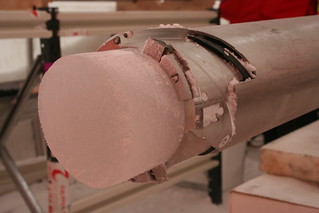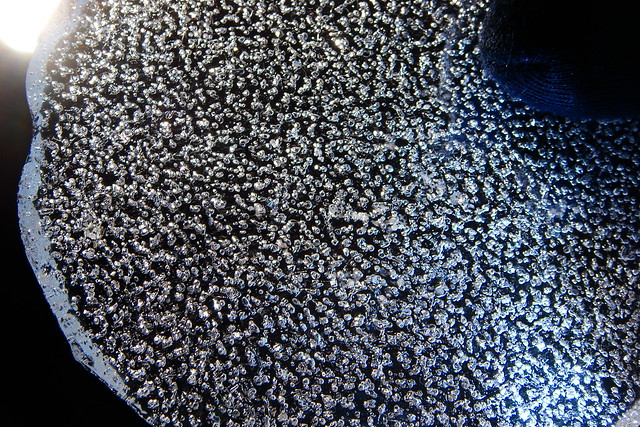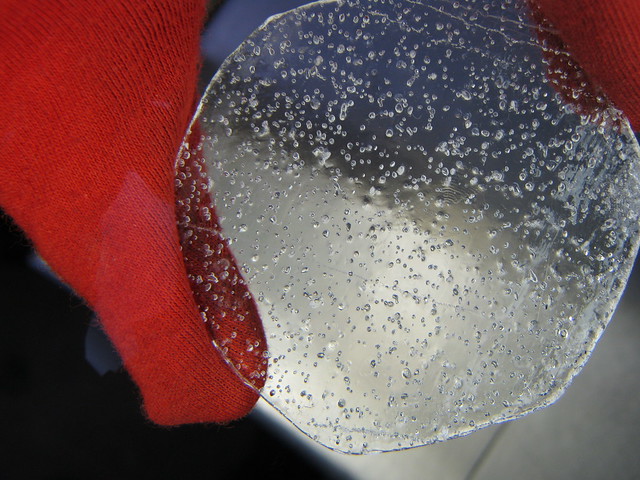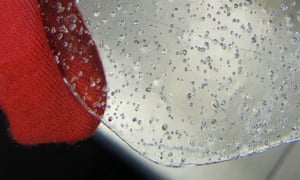http://e-info.org.tw/node/117481
「地球打的嗝」 南極冰封氣泡揭露暖化機制
文字大小
166 1 Share1
本報2016年8月3日綜合外電報導,姜唯編譯;蔡麗伶審校
冰核中的氣泡記錄著地球數萬年前的大氣狀態。澳洲氣候科學博士艾瑟瑞吉(David Etheridge)說:「地球所打的每一個嗝,都會被羅穹記錄下來。」
羅穹(Law Dome)是南極東部一個特殊的地點,科學家在此鑽開永凍土,挖出冰核進行研究。
冰核切片可清楚看到不少氣泡封存其中。圖片來源:CSIRO Australian Antarctic Division
澳洲、英國和義大利科學家分析小冰河期冰封的氣泡發現,地球每升溫1°C,地表由植物與土壤形成的陸地生物圈,就會釋放20ppm的二氧化碳進入大氣。因此,大氣中的二氧化碳含量持續升高。
小冰河期(Little Ice Age,LIA)約始於西元1500年,歷時約250年。這段期間,全球溫度低約0.5°C,大氣中二氧化碳含量也較少,不過科學家並不清楚其原因。有一個理論認為,當時流行病肆虐美洲和歐洲,使農業活動減少,植物重新長出,吸收了較多的二氧化碳。
 |
| 科學家挖出南極冰核進行氣候研究。攝影:DavidEtheridge;圖片來源:CSIRO |
但是科學家分析冰核中的羰基硫化合物發現,陸地生物圈吸收二氧化碳增加的原因並非植物增加,而是溫度下降。這表示當地球變暖,地球上的植物和土壤所儲存的碳會減少,大氣中的二氧化碳則會增加。
艾瑟瑞吉和研究團隊發現,隨著暖化持續,陸地生物圈在氣候系統中會有「正回饋」的反應。
「溫度越高,陸地生物圈釋出越多二氧化碳,進而使得溫度再升高。」艾瑟瑞吉說。
碳如何在大氣和植物與土壤之間流動,是科學家關注的重要議題。科學家替人為碳排設定「預算」。碳排在預算內,則升溫控制在2°C內;碳排超出預算則升溫將超過2°C。
如果陸地生物圈釋出的二氧化碳超過模型所預測,世界各國的碳排預算將會減少。聯合國碳預算顧問、氣候科學家海爾(Bill Hare)表示:「如果正回饋機制為真,減排需求將更加急迫,才能減緩正回饋和碳預算的消耗。」
冰核中的氣泡。攝影:DavidEtheridge;圖片來源:CSIRO
What the Earth's frozen burps tell us about global warming
Analysis of bubbles trapped in ancient Antarctic ice suggests that as the planet heats up, plants and soils will add more carbon dioxide to the atmosphere
“When the earth burps, Law Dome records it,” says Australian climate scientist Dr David Etheridge.
Law Dome is a special spot in eastern Antarctica where scientists have been drilling down into the continent’s long-frozen surface to pull out cores of ice.
Trapped in the ice cores are bubbles that give a record of the composition of the Earth’s atmosphere going back tens of thousands of years.
New analysis of those bubbles by a group of Australian, British and Italian scientists could have just given an answer to a crucial question.
As the Earth gets warmer, how will the planet’s soils and plants react? Will they start to “burp” too much CO2 and, if so, how much?
Answering this question is crucial as scientists try and work out just how much more greenhouse gases humans can afford to emit while still keeping to temperature targets agreed at the Paris climate talks last year.
The new ice core analysis, published in the journal Nature Geoscience, suggests the news is less than encouraging.
The research finds that for every 1C of warming, the Earth’s plants and soils – the “terrestrial biosphere” – will add carbon dioxide to the atmosphere to the tune of about 20 parts per million. Levels in the atmosphere continue to climb.
But to arrive at this number, the scientific team went back to analyse bubbles trapped in the ice during the Little Ice Age (LIA) – a period which started around the year 1500 and lasted for about 250 years.
The ice cores used in the study were drilled from the late 1980s to the mid 2000s and are stored near CSIRO’s Aspendale lab in Victoria and at the Australian Antarctic Division in Tasmania. The study also used data from ice cores drilled by the British Antarctic Survey 20 years ago.
Etheridge, a principal research scientist at CSIRO and co-author of the new research, has been to Antarctica seven times and is a veteran of ice core drilling programs.
Working temperatures for scientists at Law Dome can range from a balmy minus 5C (Etheridge claims T-shirts are worn. I don’t believe him) to a blustery -20C to a clear but frigid 50 degrees below freezing (that’s -58F).
Little Ice Age
During the LIA, temperatures globally cooled by a half degree Celsius or so and the amount of carbon dioxide in the atmosphere dropped.
Etheridge says: “Before the industrial revolution there were changes in the global temperature and we have observations of that from the ice cores. This Little Ice Age was a natural event triggered probably by volcanoes going off and a slightly weaker sun.”
Scientists have known that atmospheric CO2 dropped during the LIA, but were not sure why.
One theory was that as pandemics swept through the Americas and Europe, this reduced the amount of farming activity. In turn, the regrowth sucked more CO2 back into soils and plants.
But by analysing another compound trapped in ice cores – carbonyl sulfide – the scientists were able to show it was the falling temperatures, rather than the regrowth of plants, that caused the terrestrial biosphere to suck up more CO2 (and in turn, cut atmospheric levels of carbon dioxide).
On the flip side, this now means that as the planet warms, the Earth’s plants and soils will likely store less carbon and help push up CO2 levels in the atmosphere.
Essentially, Etheridge and his colleagues have found that the Earth’s terrestrial biosphere acts as a “positive feedback” in the climate system as global warming continues.
“More warming, leads to more CO2 from the terrestrial biosphere, which leads to more warming,” says Etheridge.
Etheridge explained there was some good and bad news from the study.
The good news was that the findings suggested that some of the worse predictions of a potential feedback from plants and soils were probably now ruled out. “We now have a number to work with,” he said.
But the bad news was that the “positive feedback” was now confirmed, ruling out other studies that had predicted lower amounts of CO2 being released from the terrestrial biosphere, or not released at all.
Carbon cycle
This flow of carbon between the Earth’s atmosphere and its plants and soils is a vital issue for scientists to understand.
Scientists have started to set “budgets” for the amount of carbon dioxide that can be released by humans while still have a shot at keeping warming well below 2C.
If the terrestrial biosphere adds more CO2 to the system than models anticipate, then this could mean governments around the world have less in that carbon budget than they thought.
Climate scientist Dr Bill Hare, founder of the respected group Climate Analytics, has been a key adviser to governments and the United Nations on carbon budgets.
I asked him for his view on the Nature Geoscience paper, which he described as “elegant” (I’ve found this is a word scientists often use when they’re mightily impressed with someone else’s work).
Hare said: “The paper shows a significant positive feedback from warming on the terrestrial carbon cycle. If this were to operate at this level in the future it would significantly reduce the available carbon budget for fossil fuel CO2 emissions, compared to present mid range estimates.”
Hare said the findings would “tend to push the budgets towards the lower range of the estimates available at present”.
“If there is a positive feedback as the authors calculate, this would only add to the urgency of reducing emissions as rapidly as possible in order to minimise that feedback and to minimise the impact on the remaining carbon budget.”
Roughly translated, all of this means that ice bubbles from the frigid Antarctic have just made the job of cutting fossil fuel emissions even more urgent.




沒有留言:
張貼留言